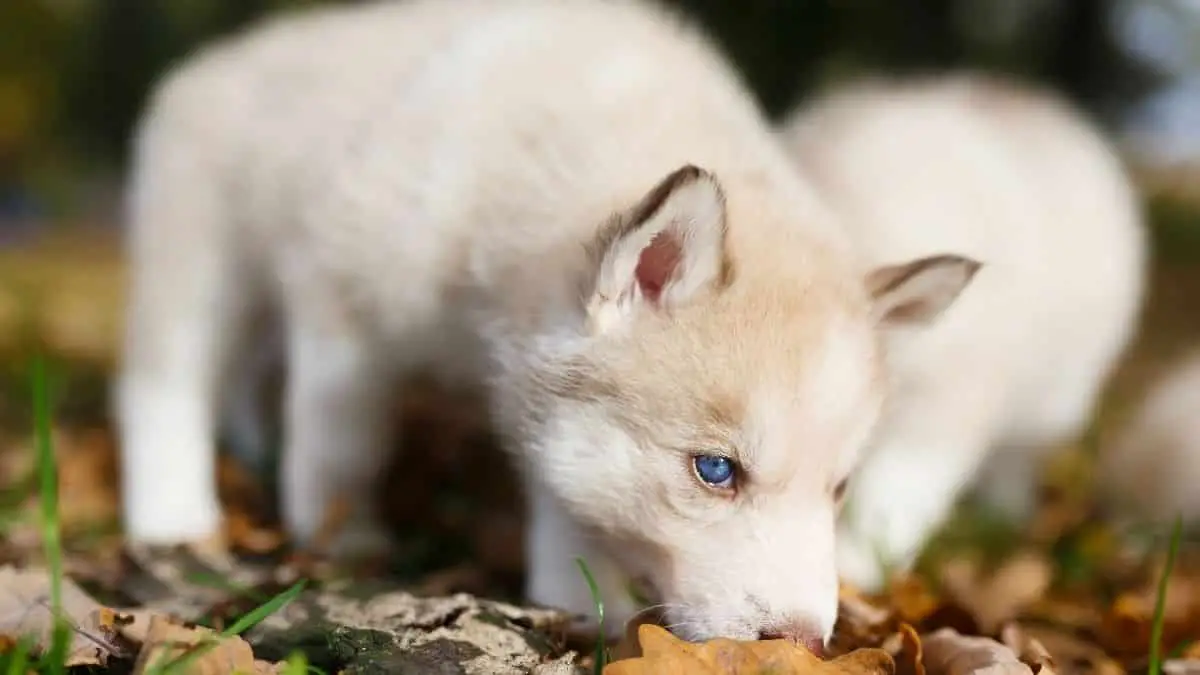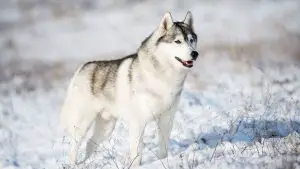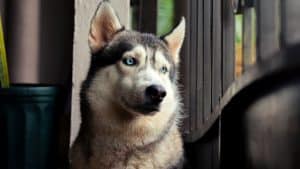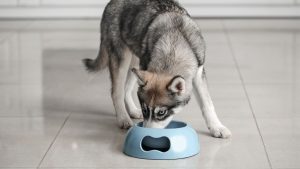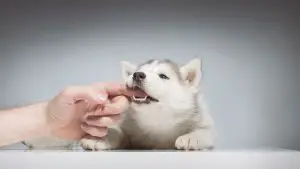Husky Whelping Information: 4 Things You Need to Know (+FAQ)
Everyone loves a newborn puppy, right? What about several newborn puppies? Well, if you have a pregnant Husky on your hands, this is exactly what you have to look forward to! Whether it is your first time whelping a litter of Huskies, or you’ve been down this road before, you should make yourself familiar with some of the particulars of this process.
Siberian Huskies will whelp at the end of the gestation period. Whelping refers to when a female dog gives birth. Their gestation period is usually between 60-64 days, although this is only a rough estimate, as one can never be exact when it comes to predicting a dog’s pregnancy. These days are counted from your female Husky’s last day of heat.
Although your amazing Husky will do most of the whelping work, there are one or two things you can do to make life easier for both her and for yourself. As well as understanding the basics of Husky puppy whelping, you should also be familiar with the set up you will need in your home to keep your Husky calm and comfortable throughout the labor and birthing process.
Table of Contents
Preparation for Whelping
There are some important things that Siberian Husky owners can do in preparation for the whelping process.
When you have a pregnant Siberian Husky on your hands, particularly when it comes to the latter stages of their pregnancy and they get close to whelping, you should keep a very close eye on her. Obtain the number of a reliable veterinarian, ideally one experience in canine births, and keep it handy in case of any emergencies.
Another important thing is to prepare a whelping box. This will help prevent your Husky mom from giving birth to her puppies in a hidden, unknown, and dark location as they would usually do in the wild. Line the whelping box with clean towels for comfort, warmth, and easy cleanup!
Just like other breeds of dogs, Siberian Huskies prefer to whelp in a dark and quiet place. In fact, this is often why dogs will tend to whelp at night! If you do not prepare a whelping box, you may find your Husky will try and hide in a dark place. Therefore, it is essential to keep your prepared whelping box in a room in your house that can be kept dark and quiet, with a steady ambient temperature.
Another indication of impending birth is your Husky’s own body temperature. In the last days of pregnancy, take your Husky’s temperature frequently. When her temperature drops below 100 degrees, then it is likely that she will begin labor within the next 8-12 hours.
Labor
When the labor stage begins, it can last anywhere between 3 and 12 hours. This is the point you should call your vet and inform him/her that your Siberian Husky is in labor. By doing this, your veterinarian will be prepared to assist you in case of a birthing emergency. Unless your Husky has a difficult birth, it is usually not necessary to keep your vet updated on the whelping progress.
However, if the labor process lasts longer than 12 hours, or you notice that your Husky is straining to give birth, call your vet immediately.
You will notice a distinct discharge from your Husky’s vulva – it will usually be light red or brown in color. She may even begin to lick at her vulva. This signifies that the whelping process is about to begin. Soon there will be contractions that will make your Husky’s belly rock hard. If you place a hand against your Husky’s belly during a contraction, you will be able to feel it, even if it is not otherwise visible.
The Birth
Generally, Siberian Huskies do not need much assistance giving birth and ideally, you should leave your dog alone, only keeping a watchful eye over the process.
Your Husky may need help at some stage during the labor process. You will usually be able to sense when something wrong, or you may even notice her panicking. In this case, call your vet immediately.
In some instances, you may be able to help your Husky in small ways. For instance, you could help with the removal of the placentas (although she will usually eat these to gain some additional nutrients and energy) or by cutting the umbilical cord.
After whelping, your Husky will be very tired, very hungry, and very thirsty. At this point, ensure that your dog has access to her food, and provide plenty of nutritious food and water in close proximity to her. She will not want to leave her puppies’ sides, so hang food and water bowls over the edge of the whelping box.
Although it is possible that your Siberian Husky may be able to relieve herself and go the bathroom as usual (outside, for short periods of time, on a leash), it is much more likely that she will be too tired and too protective to stir far after the whelping process. Some puppy training pads can come in useful here, so have a supply on hand.
Although it is tragic, do not panic if a puppy or two dies during the whelping process. This is actually quite a regular occurrence, and although it is a circumstance that would make any dog lover sad, it is also a circumstance that you should prepare yourself for. Puppy mortality can be reduced by keeping the whelping environment clean and germ-free, giving a lot of emotional support to your birthing Husky, and helping her relax, particularly if she is an anxious mother or a first-time mother.
Whelping Arrangements
There are a couple of things you can do to make the birth of husky puppies as pleasant as possible.
- You should ensure that the surroundings have as little distraction as possible. A separate room would be the ideal setup. Keep your Husky dog out of any draughts or patches of direct sunlight – dark, cool, and quiet should be your watchwords!
- The process of giving birth (not to mention having little puppies running around!) can get messy. It is something you cannot avoid and is simply a part of the whole process. You can make this situation a little easier to handle and keep your life easy by investing in a proper whelping box, a washable liner mat, and plenty of soft, warm towels.
- It’s not just the new mom who will need towels either! Make sure you have plenty of spare towels and blankets nearby to keep each puppy warm and cozy as they are born. If your Husky is having a large litter, she may be too busy birthing to keep the older pups snug, so this is where you will need to step in!
Frequently Asked Questions
What does whelping a puppy mean?
Whelping is the process where a dog gives birth, so the term ‘whelping a puppy’ refers to the process of a female dog giving birth to a puppy.
Most dogs are able to whelp on their own without any assistance – after all, this is what they typically do out in the wild! You should keep an eye on your dog during the later stages of pregnancy (and while she is in labor of course!) to keep an eye out for any potential complications.
Dystocia is when your dog encounters difficulties during labor. Dystocia requires immediate, emergency veterinary attention.
When should I whelp my puppy?
Your adult Husky dog will be the best judge of when it is time for the whelping process to begin. Some of the signs that your dog is ready to whelp include:
- Restlessness
- Panting
- Lack of appetite
- Nesting (burrowing in or digging around her whelping box)
- A small amount of bloody mucus passing from her vulva
This process can last anywhere between 6 and 12 hours, although it can also last for up to 36 hours for a first-time mom or nervous dog.
As her contractions become stronger, your dog should ideally settle down in her whelping box.
You can help the mother-to-be throughout this process by keeping her calm and ensuring she has easy access to her birthing box.
How long do Husky puppies need a whelping box?
Your puppies will gradually become more independent as they age, and by the time they are around 20 days old – or approximately 3 weeks – they will be attempting to climb out of their whelping box on their own.
After this time, your puppies will gradually become more and more independent. You might even be shocked at how quickly they will start to grow up! At around four weeks of age, the litter will begin to start playing, running, and jumping around.
It is important that you keep an eye on your puppies during this critical development stage. If your puppy’s development seems slow or impaired in any way, seek the advice of a veterinarian. Even a couple of days can make the difference in ensuring the long term health of newborn puppies.
How do you whelp a litter of Husky puppies?
Luckily, the mother-to-be will do most of the work for you in this regard! There are a few ways you can prepare for the actual time of whelping, however, that can both help the bitch out and ensure you deliver a healthy, happy litter of pups.
Once you have a confirmation of pregnancy, you can predict the most likely times your bitch will whelp. A dog’s pregnancy typically lasts anywhere between 57-71 days, but most likely falls around the 63-day mark.
Keep your whelping female as comfortable as possible during the last week of pregnancy. She will become increasingly restless in advance of whelping and will need your help to remain cool and calm.
When the mother starts whelping, keep track of her contractions. The first puppy will usually take the longest to be born, sometimes up to four hours, but usually within 20-30 minutes after the onset of contractions.
After the first puppy, keep track of how the minutes between puppies being born. This gap can range from five minutes to 90 minutes. If at any stage, if your whelping female is straining or having strong contractions for 30 minutes without progressing, call your vet immediately.
Puppies are usually born head first, but will sometimes be turned around and born tail first. Each puppy will also usually be accompanied by a placenta – your bitch will usually eat this. You will also notice that the mother dog will have a slight reprieve between puppies, and will clean off the thin birth sac surrounding each puppy and lick them.
In total, the process can take anywhere between 3 and 12 hours, depending upon litter size.
What do I need for puppy whelping?
The preparations for puppy whelping are fairly basic. Most importantly, you should ensure that you have a suitable whelping box for your female Husky. You can either purchase a box or make one yourself. A sturdy, large cardboard box will usually suffice.
Set up your whelping box in a safe, quiet, and comfortable room. Your female Husky will need as much peace and quiet as possible during the labor and birthing process. Ideally, your whelping box should be in a room that is kept at a steady temperature (around 70 degrees is ideal).
Keep your dog’s box warm and comfortable by lining it with clean absorbent bedding (towels are great here – make sure you have a few extra on hand to help with the future clean up!). The box should also be large enough for your dog to comfortably turn around and move in.

